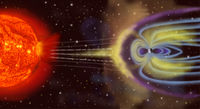
Photo from wikipedia
During 9–10 September 2011 the ACE, Wind, and SOHO spacecraft measured the complex interaction between an interplanetary coronal mass ejection (ICME) and a corotating interaction region (CIR) associated with the… Click to show full abstract
During 9–10 September 2011 the ACE, Wind, and SOHO spacecraft measured the complex interaction between an interplanetary coronal mass ejection (ICME) and a corotating interaction region (CIR) associated with the heliospheric sector boundary. Except for a few short periods, the suprathermal electrons are unidirectional, suggesting that the ICME magnetic field has opened through interchange reconnection. Signatures of interaction are distributed throughout the event suggesting that the structures have become entangled or embedded. Since the ICME speed is relatively low, the strong forward shock must be caused by the ICME-CIR interaction. Other interesting features are the upstream heating flux discontinuity, the very high proton density in the frontal boundary of the heliospheric plasma sheet and the forward shock, the significant speed elevation within the sheath, the distortion of Bz in the magnetic cloud, the indistinct location of the stream interface, the unidirectional domination of the suprathermal electrons, and the reverse shock at the CIR rear boundary. There is an unusual delay between the proton density and temperature profiles. Furthermore, large differences in proton speed and forward shock density measured between L1 spacecraft indicate high variation at small spatial scales. A few days earlier, STEREO B recorded the undisturbed CIR, which shows that (i) some general features of the CIR are preserved, (ii) the CIR is compressed by a factor of ∼4 by the ICME, and (iii) a magnetic exhausted region at the front of the CIR is a continuous feature and is not formed due to the ICME interaction.
Journal Title: Journal of Geophysical Research
Year Published: 2018
Link to full text (if available)
Share on Social Media: Sign Up to like & get
recommendations!